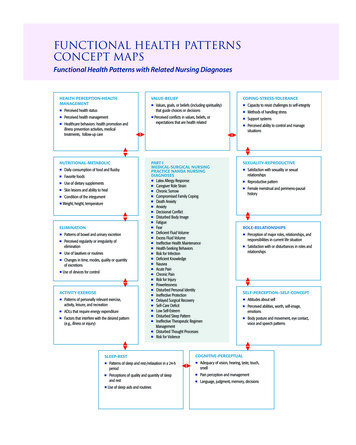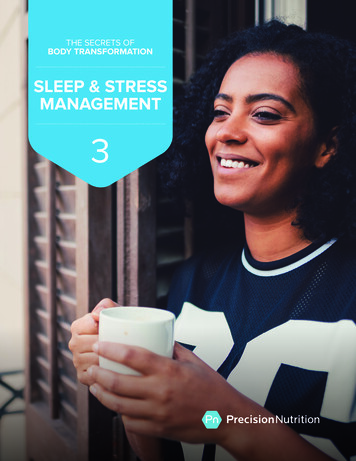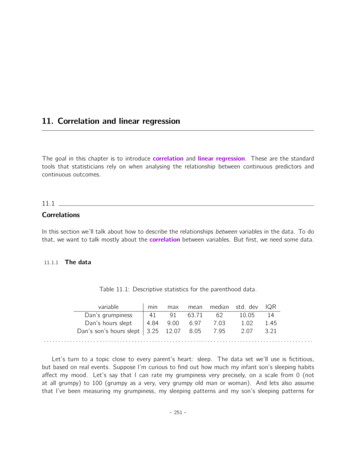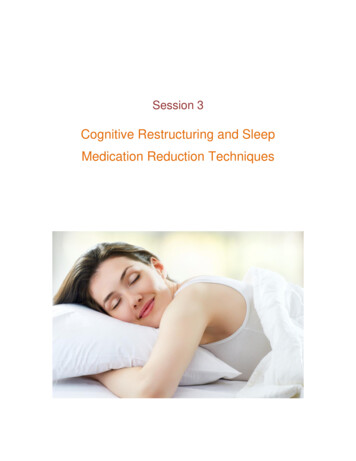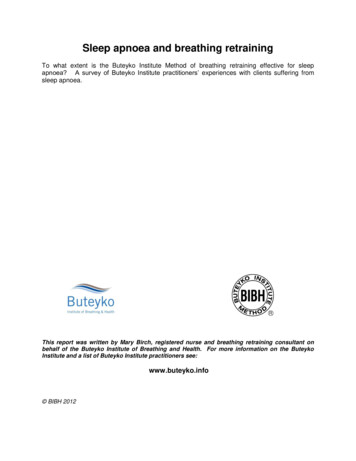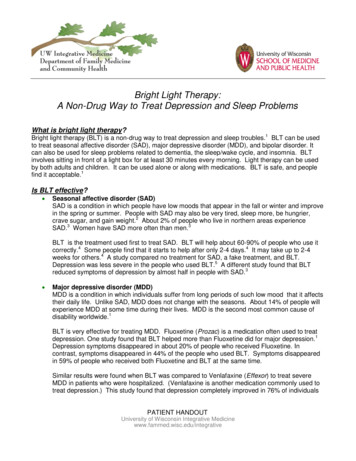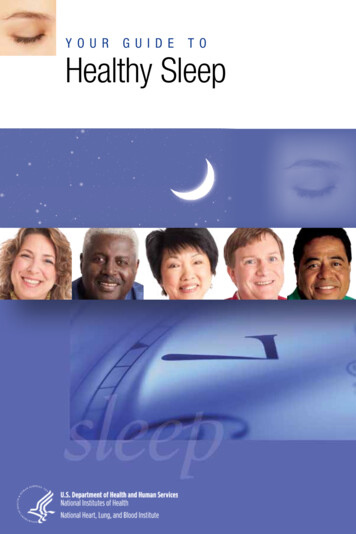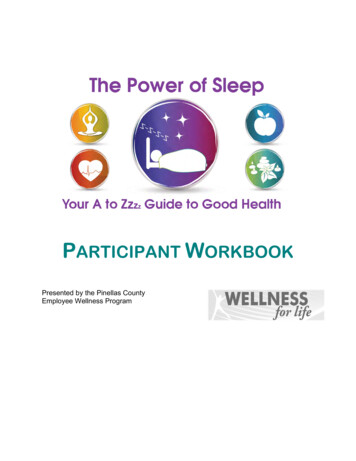
Transcription
PARTICIPANT WORKBOOKPresented by the Pinellas CountyEmployee Wellness Program
Session 1: Sleep BasicsNational Sleep StatisticsLet’s take a look at some statistics first.Depending on where we live in the country, one-third to one-half of Americans reportthey sleep 6 hours or less.Almost 40% of Floridians report 6 hours or less sleep per night.Adults Getting More Than 6 Hours of Sleep per NightData Source: National Health Interview Survey (NHIS); Centers for Disease Control and Prevention,National Center for Health Statistics (CDC/NCHS)Page 1
Rally Health Survey OverviewThe 2018 employee health survey shows that we are fairly close to the state andnational averages.1,039 employees answered the sleep question in the survey. 65% of those employees (in the yellow and green areas of the donut)responded that they get 7 or 8 hours of sleep35% of this group gets 6 hours or lessHere’s what this means in terms of claims cost to employees and the County (bargraph): The left bar on the graph shows that employees who get 7 or more hours ofsleep a night cost the County roughly 4,500 a year in medicalreimbursement. This number represents the amount UnitedHealthcare paysafter discounts but does not include the member responsibility (the amountyou pay).These averages exclude catastrophic cost (specific high-risk conditions suchas cancer, unforeseen traumas such as car accidents and other severeinjuries).The middle bar shows that employees who get about 6 hours of sleep pernight cost about 4,650 per year.Employees who get less than 6 hours cost 5,000, or about 500 dollarsmore.As you can imagine, high claims cost paid also means a higher member responsibility(the part that you pay).Lack of sleep not only affects our health, it also affects our personal finances.Page 2
What is Sleep and Why Do We Do It?The definition of sleep from Merriam-Webster:“The natural periodic suspension of consciousness during which thepowers of the body are restored.”Why humans sleep has eluded doctors and scientists for millennia. It’s one of thebiggest biological mysteries.Sleep is one of the four basic drives in life, along with: To eatTo drinkTo reproduceTo sleepBUT sleep is: More than just a basic life driveMore than just a lack of consciousnessComplexBiologically activeIf we look at it from an evolutionary standpoint, sleep actually seemslike a waste of time. When we’re asleep, we cannot gather food or drink, we cannot besocial or find a mate. Sleep leaves us vulnerable to predators. Asking why we sleep,however, is too simple of a question, because it implies there’s only one function. Wetend to think of sleep merely as a state of unconsciousness, when in fact it is complexand an extremely biologically active endeavor, providing vital restoration and health forboth brain and body.Sleep FactsAll living beings sleep –even flies!Page 3
Why Sleep MattersThere are four pillars of health that work together to create wellbeing: physical, social,emotional and financial. Optimal health requires that we achieve balance between allfour pillars. None, however, can be achieved without proper sleep.Every major organ (including the brain) and tissue suffers if you are sleep deprived.Countless large scale studies across industrialized countries that have included peopleof all gender, race, ethnicity and age have irrefutably come to the same conclusion: theshorter the sleep, the shorter the lifespan.Sleep FactsWe lose about 1 liter of waterthrough our breathing each night.When you wake up each day,drink 12-16 oz. of water first thingin the a.m. (room temperature).This helps to replace water loss.Page 4
Emotional & Mental Health BenefitsAreas of the BrainDifferent parts of the brain take part in regulating our mental health. If you took theStress-Proof Brain Wellness Series, you may remember the parts of the brain that affectstress: Amygdala - fight or flight response, exaggerated emotionPrefrontal cortex (hypothalamus) - the brain’s CEO, reasoning and logicalthinkingHippocampus - the brain’s biographer, memoryTogether, these brain area connections work to regulate emotions as well. We’ll explorethese more in a later class.Nature’s Best MedicineThe power of a good night’s rest is astounding. It is nature’s best medicine, a free, dailyprescription that helps us feel better. Recalibrates brain circuitsImproves navigation of social and stressful situationsControls rational thinkingRe-sets the brain to create new memories and imprint older onesManage depression, anxiety and other mental health disordersSleep FactsWait 90 minutes for yourfirst cup of caffeine. It’s adiuretic and will causeadditional water loss.Have a second cup ofwater and then reach forcoffee.Page 5
Sleep Deprivation & Social ConnectionIf you are sleep deprived, you may have trouble with: Interpreting your environmentProcessing emotionsWorking well in a teamDecision-making, problem solvingPersonal relationshipsEmotional controlReasoningEmpathySleep also impacts not only our desire for social connections, but our ability to navigatethem effectively diminishes when we’re tired.A sleep-deprived brain has trouble reading facial expressions and is more likely tointerpret faces as threatening. As such, they are less likely to engage in conversationswith others and may be very irritable.Sleeplessness also affects the ability to process emotions - meaning sleep-deprivedindividuals often gauge the feelings of other people inaccurately, which reduces theirability to empathize.Both personal and work relationships suffer.Lack of these crucial abilities negatively affects communication, teamwork, trust, andcooperation. Teams with sleep-deprived members could potentially experience a lack oftrust, teamwork and effective problem solving.Brain Re-bootYou need sleep so your brain can re-boot and soyou can: Effectively manage stressImprove memoryHave more energyIncrease attention span andability to concentrateStrengthen relationshipsPage 6
Body Health BenefitsSleep: Reduces blood pressure and keeps the heart healthyRegulates hunger hormonesControls blood sugarHelps fight off infection and improves healingThese processes: Prevent and help manage health conditions such as Heart diseaseDiabetesCancerObesityAssist with weight controlBoost immunityHow Much Do I Really Need?It is mind-boggling how sleep affects so many processes in our bodies. You’ve probablyheard that doctors and scientists say we need about8 hours of sleep. In this case, scientistsdefine “need” by whether the amount ofsleep obtained is adequate to complete allof the processes it’s designed for. Whenwe say, “I only need 6 hours of sleep,” wetend to use a different definition of need:The number of hours I get/or need to getthrough the day. However, with chronicsleep deprivation, our bodies willacclimate and learn to function onless sleep, giving us a false sensethat we are giving our bodiesenough time to re-set.Exact sleep requirements canvary from person to person. Youmay need slightly less or slightlymore than 8 hours, but the factremains that if you’re getting less than7, you’re not getting enough to reap the benefits, and in fact, aredoing your health a huge disservice.The amount of sleep needed depends on a variety of factors such as age, physicalexertion, health (are you fighting the flu?), pregnancy, etc.Page 7
How Much?Sleep OpportunityThe recommendation includes timefor sleep opportunity, not just thehours actually asleep.Sleep opportunity is the time wephysically get into and out of bed.When we get into bed at 10 p.m.and wake up at 6 a.m., we giveourselves 8 hours of sleepopportunity, giving ourselves timeto fall asleep, reach deep sleep andwake up naturally. The time spentasleep is usually about an hour less.Although sleep time is less than 8 hours, this additional time we allow ourselves tomove through stages of the sleep cycle is just as important.Thus, if you get into bed at midnight and wake up at 6 a.m., the sleep opportunity is 6hours, but actual sleep time is roughly only 5 hours, falling far short of therecommendation for good health.Are you sleeping?Universal indicators of sleep: Usually horizontal positionLowered muscle tone and relaxation of postural musclesNo signs of communication or responsivityEasily reversible (unlike coma, anesthesia, or death)Was I asleep?When we wake up, we automatically know we’ve been sleeping, and we can also gaugewhether we slept well or not.We experience: Loss of awareness of the outside worldTime distortion – don’t know how long or what time it is when we wake upPage 8
Sleep By YOUR NumbersAssessing our own sleep habits can be extremely helpful inbringing awareness to ways in which we can improve it. Weare going to do so in two ways. A quick sleep assessmentTrack our sleep and keep a sleep diary for thenext 4 weeksSleep AssessmentTotal your score and take a look at the point ranges. The lower the score, the lower thesleep health.Now ask yourself - Do you feel tired during the day? Or do you drink so much caffeineto numb your tiredness that you can’t fall asleep when you finally have the chance? Inorder to decide how much sleep you need, it’s important to note how your bodyfunctions and feels throughout the day.Page 9
Sleep TrackingIt should take 20-30 minutes after you get into bed to fall asleep. Any sooner than that,and you’re probably too tired. Any longer than that, you may be getting too much sleep.In the morning, you should wake up ready to take on your day. You may or may notwake up a little bit before your alarm, but if you do, you’re more than likely gettingenough rest.To determine how much sleep you need, let’s start by noting how much you’re gettingnow, how you feel, and your lifestyle behaviors. There are many variables that couldmake finding sleep hard.You’ll find a sleep diary in the Resources section in the back of this workbook. It mayseem like a lot of effort, but if you’re serious about feeling better and becominghealthier, it’s worth it.In the morning, assess your sleep the night before. In the evening, take note of how youfelt during the day, and the things you drank, ate and did.Notice the first morning box asks what time you went to bed and woke up, and the timeyou slept. This measures your sleep opportunity as well as actual sleep duration.Page 10
Work through the boxes and take additional notes if you need to.In the evening, assess your caffeine and alcoholic beverage intake, energy and activitylevels. Were you excessively hungry/craved carbs? Had trouble concentrating? Feltirritable? Too tired to exercise? These can all affect your sleep quality and duration.At the end of the day, compare your morning notes with your evening notes. Do you seeany connection?Sleep TrackersA note about trackers If you’re using a Fitbitor other wearable device, you can pull theinformation from the app; however, use thediary as well to observe additional informationthat will help identify your daily habits. Don’tworry if you don’t have a sleep tracker; it is notneeded to use the diary.If you’re interested in trying a sleep trackerapp, there are free and subscription-basedapps both for Android and iPhone.Keep in mind that the only accurate way to measure sleep is a sleep study done at asleep clinic. Both wearable devices and sleep tracker apps have limitations as to theiraccuracy. They’ll provide a general idea of sleep quality and duration but should not beused to self-diagnose any type of sleep condition.Page 11
Adjusting SleepOnce you’ve spent a week getting an idea of your sleep and lifestyle patterns andmaking necessary adjustments, continue to keep a sleep diary and follow these steps:Go to sleep 15 minutes earlier every 2-3 nights, until you’re getting at least 7 hours ofsleep every single night.Use a sleep calculator tool to figure out what time you need to go to bed to achieve thehours of sleep you’d like (don’t forget to factor in sleep opportunity). See the BedtimeCalculator on the National Sleep Foundation’s website.If you’re still tired during the day or you’re not ready to wake up when your alarm goesoff, move your bedtime 15 minutes earlier.Continue this process until you are getting enough sleep every night. You’ll probablyend up somewhere between 7 and 9 hours, but listen to your body and follow its needs.Keep in mind that this only determines how much sleep you need right now. Ifsomething changes in your life, your sleep needs could change, too. Or, as you becomemore and more rested, you may find that you need less sleep.Page 12
Session 2: Engineering SleepReviewSleep is universal to all living things.Sleep is the foundation for all the pillars of wellness: PhysicalSocialEmotionalFinancialSleep is very complex and biologically active.Engineering SleepWatch the video.Page 13
Sleep SignalsThe Sensory Gatekeeper:The ThalamusWhen we’re awake, we’re aware of all ofour senses. We can smell, see, hear,taste and touch. These signals allconverge in one central area of the brain.As we fall into slumber, they continue tocome together in the zone; however, thethalamus, which acts as the sensorygatekeeper, blocks these signals fromreaching the cortex of the brain. Thecortex allows us to consciously perceivethe senses.While the organs continue to receive thesignals when we are asleep, thethalamus induces a state where we loseconsciousness with the outside world.BrainwavesWhen we are awake, our electrical brain signals (brainwaves) are very frenetic andincoherent because we’re constantly processing and responding to the real worldenvironment. When we move into the sleep stages, brainwaves become longer andslower the deeper we sleep.A good analogy for brain cell activity in wakefulness is to think of them as people seatedin different parts of a large stadium. If you placed a microphone in the middle of thestadium, you’d hear a cacophony of noises from all areas, as the people are all havingtheir own conversations. In Non-rapid Eye Movement (NREM) sleep, theseconversations all become synchronized, increasing at thesame time with an accompanying silent pause that directlySleep Factsfollows it.Marine animals haveInterestingly, occasionally a sleep spindle, a burst ofalmost no REM sleepbrainwave activity, appears at the end of a slow wave.because the musclesSleep spindles have multiple purposes, but one of them isare turned off and theyto shield sleep by blocking out external noises.must retain musclemovement to stay awareof their environment.Page 14
Sleep RhythmsWhat time is it?Our bodies know when to wake up and go to bed based on signals from our CircadianRhythms. Along with sleep pressure and melatonin, they drive the various stages of thesleep/wakefulness cycle.Circadian RhythmsCircadian rhythms are biochemical, physiological, and behavioral cycles in all livingthings. In humans, they rise and fall in 24-hour cycles.Numerous clocks throughout the human body drive circadian rhythms. Think of them aspacemakers.Circadian rhythms are important because they: Prepare the body for expected environmentchanges (like exercise, sleep and mealtimes)ooooSet the sleep and wakefulness cyclesPromote sleepiness at usual bedtimeInitiate sleepPromote wakefulness before usualwake-up timePage 15Sleep FactsDolphins use both sidesof the brain to stayvigilant. NREMalternates between thetwo sides which allowsfor one side of the brainto be alert at all times.
Set the timing for other circadian rhythms that regulate physiology andbehaviorso Hormoneso Body temperature rhythm (higher in late afternoon and lower when wesleep)o Eating and digesting foodThe pacemaker has an internally driven 24-hour rhythm that urges the body to wake upat the beginning of the day and go to sleep at night.The day/night rhythms remain unchanged, preferring sleep at nighttime andwakefulness in the daytime.External cues also impact the cycle.Light and the BrainLight and dark are the strongest cues forcircadian rhythms. Exercise and melatoninalso appear to influence the timing of thepacemaker, but not as much as light. Normally,light enters the eye (even through closedeyelids during sleep) and signals thepacemaker to wake up, perform certainactivities, and go to sleep.Page 16
Individual Rhythms Sleep FactsRhythms vary from person to personEarly birds and night owlsPartially genetically determinedImpact work productivityNot all humans have precisely the same circadian rhythm.You probably already know whether you’re an early birdor a night owl.This is determined partially by genetics.Some seals, who spendboth time on land andtime in the water, haveREM sleep on land(when no aquaticmovement needed), andenter only NREM sleepunder water.Our own rhythms can work with or against our workschedules. If you’re a night owl and naturally prefer to goto bed late, it can be difficult to work an 8 a.m. - 5 p.m. schedule. The later sleep cycleand earlier wake time can make it challenging to concentrate, have positive workrelationships and complete work duties.Sleep PressureAnother part of the sleep cycle is something called sleep pressure, caused by a steadyincrease of the chemical adenosine in the brain, which builds up in the body duringwaking hours and causes an increasing urge to sleep.For most, this usually happens after12 to 16 hours of wakefulness. Thepressure gets stronger the longer westay awake and decreases duringsleep, reaching a low after a full nightof good quality sleep. The cyclerepeats when we wake up.The dashes in the graph show thatsleep pressure continues to increase ifwe do not sleep, and resets when wego to sleep.Our body produces a higher need forsleep under some circumstances, where sleep could be longer and/or deeper. Sleeppressure increases: During illness/infectionLearning/brain stimulationIntense physical demandPregnancyPage 17
MelatoninThe brain communicates day and night signals to the body by the way of a messengercalled melatonin. It is released into the bloodstream at dusk to send a message that it’sdark. Melatonin concentrations slowly decrease throughout the night.Example: When it gets dark earlier and nights are longer, have you ever felt like it wastime to go to bed earlier?Although it is an extremely popular sleep aid, melatonin does not have anything to dowith the generation of sleep. Think of it as the timing official at a race. It signals the startof the race but does not participate in it.It can be helpful for jet lagged individuals whose nights and dayshave been altered but it’s not a very effective sleep aid for thoseon a regular night/day cycle. However, there is a significant sleepplacebo effect which should not be underestimated.CaffeineAs adenosine builds up through the day, working with circadian rhythm and melatonin,its signal to go to bed gets louder and louder.Caffeine, which is the most widely used psychoactive stimulant in the world, fights thesleep pressure chemical for the receptor sites on the brain that welcome adenosine.Once caffeine occupies the landing sites, it masks the sleep signal, tricking the braininto thinking it’s wide awake.It takes about 30 minutes for the effects of caffeine to peak. It also has a half-life of 5 to7 hours. Half-life means the time it takes the body to remove 50% of the concentration.If you drink a cup of coffee with dinner at 7 p.m., your body would rid 50% of it at 1 a.m.,Page 18
so about half the caffeine continues to circulate throughout the body. For this reason,limiting caffeine intake to earlier in the day can be very helpful in improving sleep.Synchronized RhythmsThe red line represents when we’re awake and the blue line represents sleep pressure.Our feeling of being awake rises until it begins to diminish in the evening. At the sametime, the moment we wake from sleep, sleep pressure starts to build up again. Once wefall asleep, the pressure clears out by morning.If you have a normalday/night wake/sleepschedule, sleep pressure andcircadian rhythms aresynchronized. It would seemlogical to think that thecircadian cycle wouldcommunicate with adenosine,but in fact they do not.Although they arecoordinated to work toward acommon goal, they do nottalk to one another.De-synchronized RhythmsCircadian rhythms, melatoninand sleep pressure all marchalong on the 24-hour cycle thatinduces sleep at night and beingawake during the day. If we dothe opposite and stay awake atnight, all of these processescontinue to release signals andchemicals signaling the body tosleep at night. Thisdesynchronization causesextreme fatigue and bodydisruptions.Page 19
Sleep DebtWhen we don’t get enough sleep, we go into "sleep debt,” which builds over time. Wemust catch up on sleep to "pay down" this debt. For example, a person needing 8 hoursof sleep but getting only 6 hours would accumulate a sleep debt of 2 hours that day. Ifthey continue for 5 days, they’ll have 10 hours of sleepdebt at the end of the week.To keep sleep debt down, get the length of sleep youneed in order to feel rested when you wake up. Allowextra time to sleep if you were not able to get enoughsleep the previous night. A person does not necessarilyneed to pay back hour for hour of lost sleep since thebody sometimes sleeps more soundly to pay down thedebt.However, it is a bad idea to build up sleep debt regularlyand try to pay it off later by catching up on sleep. Althoughyour level of sleepiness may return to normal after a dayor two of recovery sleep, your brain and body functionscontinue to be somewhat compromised when compared toyour well-rested norm. It is extremely important to getenough sleep on a regular basis rather than sporadicallyon a continuous basis.Sleep CyclesPage 20Sleep FactsBird flocks line up in arow to sleep. The twoend birds act assentinels, keeping theoutside eye open andthat part of the brainwatchful for predators.Halfway through thesleep cycle, they bothturn 180 degrees, openthe other eye andactivate the other side ofthe brain.
Humans don’t just sleep, they cycle through two completely different types of sleep in 5cycles that repeat but are not symmetrical.There is more deep NREM sleep earlier in the night, whereas REM sleep predominatesin the second half of the cycle.Sleep FactsPeople who aresleep deprived donot have the abilityto gauge how tiredthey are.Page 21
Sleep Cycle VideoWatch the video.Non-Rapid Eye Movement (NREM)Physical and electrical characteristics: Inactive musclesNo eye movementSlower brainwavesHippocampusThroughout the day, our brains absorb an incredible amount of information, which isstored in the hippocampus. If you took the Stress-Proof Brain Wellness Series, you’llrecall that the hippocampus is the biographer of the brain– it writes down the stories of the day. However, it is onlytemporary storage as it has limited space. NREM sleepidentifies which of these stories are important enough tostore permanently and with every slow brainwave,transfers them into permanent storage in the cortex.If we do not get enough sleep, NREM does not effectively“clean house” in the hippocampus. As a result, we havetrouble absorbing and temporarily storing information thenext day. When sleep deprivation is chronic, it posescontinued memory problems.Page 22
Also, when we absorb information the day prior, it can sometimes be difficult to recalljust before sleep. NREM refreshes the brain and allows for recall the next morning. Aftera night of adequate NREM, we’ve all experienced a moment where we say, “Oh! Iremember now ”NREM for Skill MemoryWhen we learn new skills that require movement, like riding a bike, typingon a keyboard or playing the piano, we cannot learn them by simplyreading a book. They require repetitive and coordinated musclemovement. We often refer to this type of learning as muscle memory,when in fact, muscles do not have memory. The memories exist in thebrain, and with repetition, practice and time, the brain creates increasinglystrong neural pathways (information superhighways) to the muscle, givingit instruction to perform the skill.Research has found that increasing speed and accuracy resides in stage2 NREM sleep, especially the last two hours of an 8 hour night. Skillmemory is linked to a high number of sleep spindles occurring at thattime.Rapid Eye Movement (REM)During rapid eye movement sleep, brainwaves are fast and remarkably similar to thoseof wakefulness. If hooked up to a sleep tracking machine, the only distinguishing factorwould be that of a lack of muscle activity during REM. There is no muscle tone at all.REM sleep has other unique characteristics. In deep Non-Rapid Eye Movement(NREM) sleep, the floodgates from the thalamus to the cortex close, effectively blockingexternal “noise.” During REM sleep, the gates open, but not in the same way aswakefulness. Memories, emotions, motivations and many other signals reach the cortexand are played out in different areas of the cortex that control hearing, vision andmovement.REM sleep also produces dreams.Key functionsUnlike NREM, which stores factual memories, REM processes these signals and refinesour understanding of the real world, including insight, problem solving andcommunication. It also induces a therapeutic effect in ridding our brains of trauma andnegative emotional experiences, helping to maintain emotional health.As highly evolved animals, REM plays a role in cognitive intelligence and ourunderstanding of the complexity of society and culture.Page 23
Sleep Across the LifespanAs we age, both circadian rhythms and NREM sleep change. They interconnect with thebrain in ways that both support early brain development, or, are affected by braindegeneration later in life.In Vitro and InfantsThe brain develops at an intense and extremely directed way during this time. REMsleep acts as a fertilizer for growing brain cells, which increases electrical activity,creating and increasing millions of neural pathways and synapses between differentareas of the brain.REM sleep is vital in building the brain mainframe. The objective is quantity because thebrain creates as many connections as possible toprovide for multiple ways of absorbing informationand learning. However, this creates redundancy,which is addressed later in childhood. Also, baby’scircadian rhythms don’t develop until after the firstfew months of life where they finally start to showsigns of sleep rhythms. This explains the erraticsleep of a newborn.In the womb, a fetus spends the majority in REMsleep and babies split their time 50/50 betweenREM and NREM. Sleep disruption during this time is extremely serious as vital braindevelopment halts if REM sleep is interrupted. Over time, it never fully catches up.A good analogy for early developmental brain growth is that of an internet serviceprovider laying fiber-optic cables in a new neighborhood. They lay the same type ofcable to all homes, providing the same bandwidth.Page 24
ChildhoodIn mid to late childhood, the brain builds and learns from millions of experiences andshifts focus to create efficiency and effectiveness. Here, the original brain architecturebegins to refine all of those connections, recognizing and choosing networks that arequicker, more useful and efficient. NREM/REM ratio shifts dramatically to a 70/30dominance of deep NREM sleep, which prunes the brain’s connections. It is also criticalin retaining new facts and cementing memories.Continuing the internet analogy, we can liken this to the internet provider researchingwhich households need more data and which don’t use much, and programming thecables to deliver stronger signals to the areas that need it most, and dial down signals inlower-use households.As children mature into adolescence, a markedly higher percentage of deep NREMsleep develops cognitive reasoning and critical thinking.AdolescenceAdolescents and young adults continue to broaden their cognitive capacity, building thebrain that will eventually develop into an adult brain capable of making complexdecisions, rational thinking, peer-group relationships and communication.They face two challenges during this stage: a later circadian rhythm and early schoolstart times.As any parent of a teenager knows, it can be frustrating to find their child awake lateinto the night and unable to wake up in the morning. It turns out this is developmentallynormal in sleep cycles and brain development. Having to wake up early for an earlymorning school start time poses a challenge for brain development and academicperformance.If you have or will have a teenager in your home, it’s important to support their sleeprather than label it as laziness. Go easy on your teenager; their brains are hard at workand need the sleep!Early Development & Mental HealthBoth sleep types (NREM and REM) are critical for brain development. InsufficientNREM in teenagers is linked to psychiatric disorders. Common disorders that appear inchildhood and adolescence: Bipolar disorderSchizophreniaMajor depressionADHDAltered or insufficient sleep during these critical stages early in life can have profoundlynegative effects on healthy cognitive function. NREM sleep in teenagers provides someunderstanding of sleep’s connection to mental health.Page 25
Adulthood and AgingIt is a myth that adults and older adults need less sleep. In fact, they need just as muchsleep as younger counterparts, and studies show they try to get enough, but aspects ofaging can make it difficult to fall or stay asleep.As we age, we experience reduced quantity and quality of sleep, reduced sleepefficiency and disrupted timing. REM sleep remains fairly constant throughout thelifespan, but NREM sleep begins to degenerate in both quantity and quality in the latetwenties to early thirties. By our forties, our time spent in NREM sleep diminishes.These restorative brainwaves decline in both number and power. By the late forties, weexperience 60-70% less NREM than teenagers, and 80-90% by the time we’re seventy.This decl
Assessing our own sleep habits can be extremely helpful in bringing awareness to ways in which we can improve it. We are going to do so in two ways. A quick sleep assessment Track our sleep and keep a sleep diary for the next 4 weeks. Sleep Assessment . Total your score and take a loo



